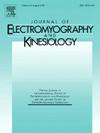基于小波的时频肌间β带相干性随年龄的增长而下降,但在独立于年龄的步态中踝关节肌肉精神疲劳后增加。
IF 2.3
4区 医学
Q3 NEUROSCIENCES
引用次数: 0
摘要
精神疲劳会影响认知功能,干扰运动表现。我们研究了在跑步机上以1.2 m·s-1的速度行走时,精神疲劳是否会通过基于小波的肌肉时频-肌间β带相干性的年龄特异性调制影响步态。采用精神运动警觉性任务、ax -连续表现和Stroop测试诱导健康青年和老年参与者的精神疲劳。精神疲劳减少了站姿时间、步幅长度和步宽,增加了节奏、步幅长度和站姿时间的可变性。在老年受试者中,与年轻受试者相比,在精神疲劳诱发前,行走时测量到的基于小波的时频肌间β带相干性在步态周期的特定阶段在胫骨-腓骨肌和胫骨-腓肠肌对中较低。在两个年龄组中,在诱导精神疲劳后,步行时测量的基于小波的肌间时间-频率β -带相干性在二头肌-半腱肌、股直肌、胫骨-腓骨肌、腓肠肌-比目鱼肌和胫骨-腓肠肌对中增加。综上所述,我们观察到,尽管老年可能会减弱步态中某些踝关节肌肉对之间的振荡耦合,反映出这些肌肉的下行驱动在一定程度上受到损害,但在精神疲劳后的步态中测量到的基于小波的时频肌间β带相干性可能与年龄无关。本文章由计算机程序翻译,如有差异,请以英文原文为准。
Wavelet-based time-frequency intermuscular beta-band coherence decreases with age but increases after mental fatigue in ankle muscles during gait independent of age
Mental fatigue can affect cognitive function and interfere with motor performance. We examined if mental fatigue affected gait through age-specific modulation of wavelet-based time–frequency intermuscular beta-band coherence in muscles while walking on a treadmill at 1.2 m·s-1. The Psychomotor Vigilance Task, and the AX-Continuous Performance and the Stroop tests were used to induce mental fatigue in groups of healthy young and older participants. Mental fatigue reduced stance time, stride length, and marginally step width and increased cadence, stride length and stance time variability. In older compared with young participants before the induction of mental fatigue, wavelet-based time–frequency intermuscular beta-band coherence measured during walking was lower in the tibialis-peroneus and tibialis-gastrocnemius muscle pairs in specific phases of the gait cycle. In both age groups, after induction of mental fatigue, selected clusters of wavelet-based time–frequency intermuscular beta-band coherence measured during walking increased in the biceps-semitendinosus, rectus-vastus, tibialis-peroneus, gastrocnemius-soleus, and tibialis-gastrocnemius muscle pairs. In conclusion, we observed that while old age might weaken oscillatory coupling between selected ankle muscle pairs during gait, reflecting a certain level of impairment in the descending drive to these muscles, wavelet-based time–frequency intermuscular beta-band coherence measured during gait after mental fatigue migth increase independent of age.
求助全文
通过发布文献求助,成功后即可免费获取论文全文。
去求助
来源期刊
CiteScore
4.70
自引率
8.00%
发文量
70
审稿时长
74 days
期刊介绍:
Journal of Electromyography & Kinesiology is the primary source for outstanding original articles on the study of human movement from muscle contraction via its motor units and sensory system to integrated motion through mechanical and electrical detection techniques.
As the official publication of the International Society of Electrophysiology and Kinesiology, the journal is dedicated to publishing the best work in all areas of electromyography and kinesiology, including: control of movement, muscle fatigue, muscle and nerve properties, joint biomechanics and electrical stimulation. Applications in rehabilitation, sports & exercise, motion analysis, ergonomics, alternative & complimentary medicine, measures of human performance and technical articles on electromyographic signal processing are welcome.

 求助内容:
求助内容: 应助结果提醒方式:
应助结果提醒方式:


